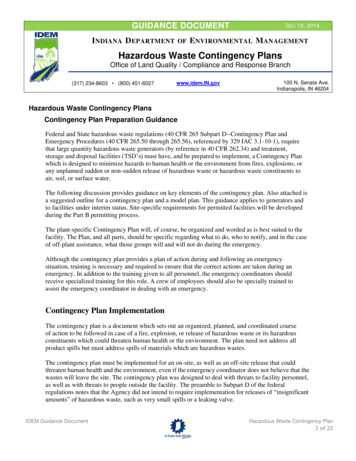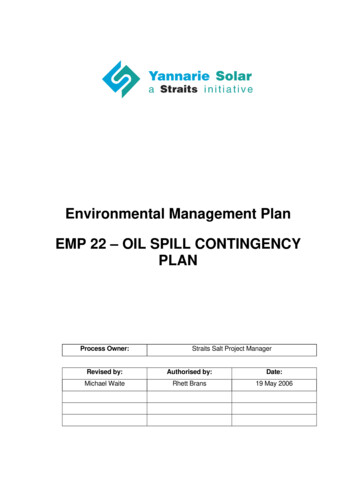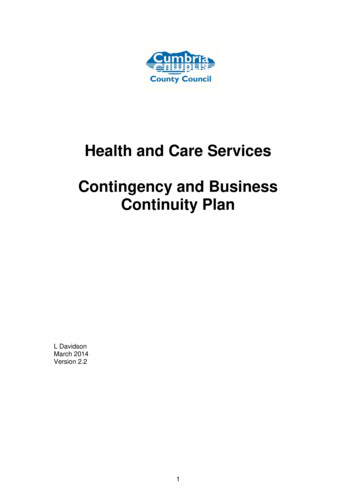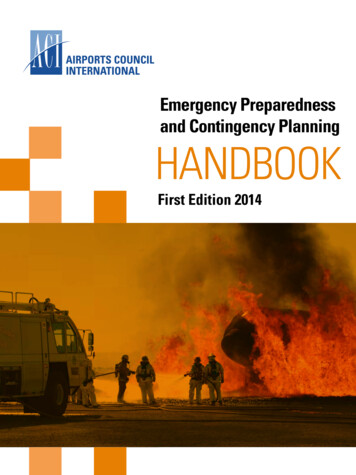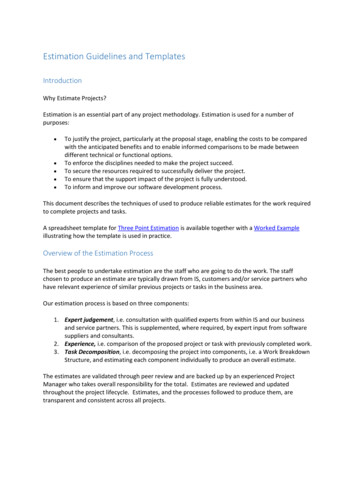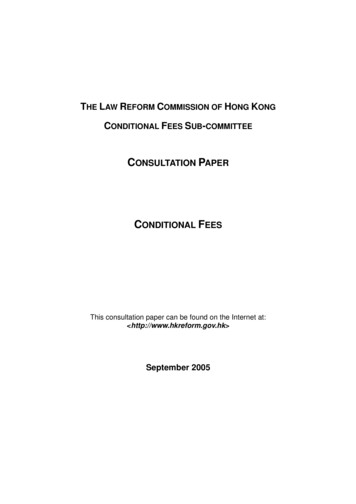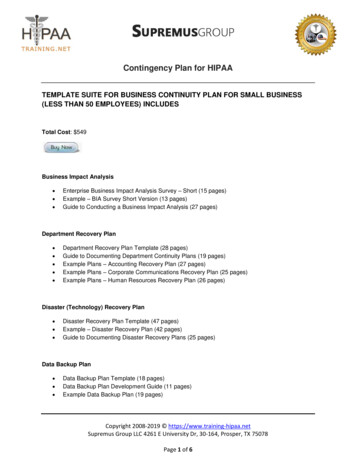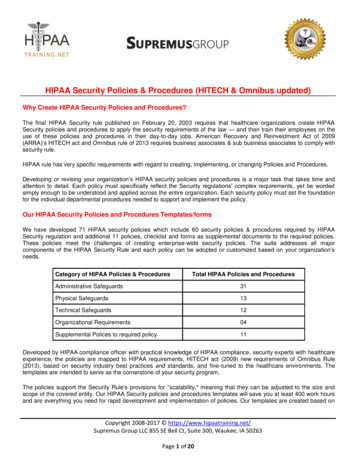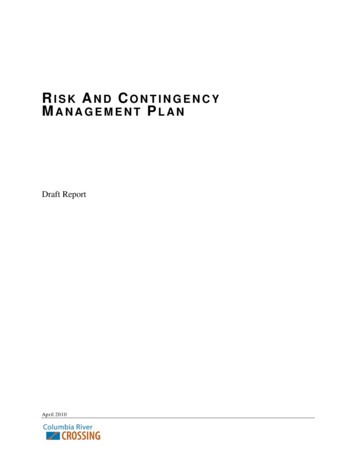
Transcription
RISK AND CONTINGENCYMANAGEMENT PLANDraft ReportAp ril 2010
Title VIThe Columbia River Crossing project team ensures full compliance with Title VI of theCivil Rights Act of 1964 by prohibiting discrimination against any person on the basis ofrace, color, national origin or sex in the provision of benefits and services resulting fromits federally assisted programs and activities. For questions regarding WSDOT’s Title VIProgram, you may contact the Department’s Title VI Coordinator at (360) 705-7098. Forquestions regarding ODOT’s Title VI Program, you may contact the Department’s CivilRights Office at (503) 986-4350.Americans with Disabilities Act (ADA) InformationIf you would like copies of this document in an alternative format, please call theColumbia River Crossing (CRC) project office at (360) 737-2726 or (503) 256-2726.Persons who are deaf or hard of hearing may contact the CRC project through theTelecommunications Relay Service by dialing 7-1-1.¿Habla usted español? La informacion en esta publicación se puede traducir parausted. Para solicitar los servicios de traducción favor de llamar al (503) 731-4128.
Risk And Contingency Management PlanDraft ReportiTABLE OF C ONTENTS1.O VERVIEW. 1-12.G OALS AND O BJ ECTIVES . 2-32.1Risk Review Process . 2-33.INS URANCE . 3-14.P RIMARY MITIGATION . 4-34.1Technical Capacity . 4-34.2Project Scoping and Design . 4-3Requirements Risks. 4-3Design Risks . 4-45.4.3Delivery Methods and Contracting . 4-54.4Construction Process:. 4-6P ROJ ECT TRACKING . 5-75.1Cost estimating & Forecasting, Financing and Financial Management . 5-76.P ROJ ECT S CHEDULE MANAGEMENT . 6-87.C ONTINGENCY MANAGEMENT . 7-97.1Cost Contingency Management Plan . Error! Bookmark not defined.7.2Schedule Contingency Management Plan . 7-148.S ECONDARY MITIGATION . 8-169.R IS K MANAGEMENT AND R IS K MITIGATION . 9-17List of FiguresFigure 8-1. Contingency Distribution to Each SCC . 7-9Figure 8-1. Typical Contingency Levels . 7-11List of TablesNo table of figures entries found.
Risk And Contingency Management PlanDraft ReportACRONYMS1-3
Risk And Contingency Management PlanDraft Report1. OverviewThe Risk and Contingency Management Plan (RCMP) is a sub-plan of the Project ManagementPlan (PMP) for the Columbia River Crossing (CRC) project dated, September 2009; itssuccessful implementation depends upon a fully updated and active PMP. The purpose of theRCMP is to highlight specific areas of management focus as identified through the risk reviewprocess, which should be implemented along with normal project operations as describedelsewhere within the PMP. Further, the purpose of the RCMP is to provide a means formonitoring project progress as it moves forward to Entry into Final Design.This RCMP contains two distinct sections, a plan and work plan (or appendix). The plan detailseffort in defining and managing the steps, actions, and risks to guide the CRC Project within thecost and schedule requirements, while maintaining target (cost & schedule) contingency levelsthrough each project phase. This portion of the document is expected to be updated only asneeded, or as requested by the FTA PMOC, i.e. entrance into a new phase and/or a change inFTA guidance.Each component of the plan provides guidance for the successful management of the CRCproject including, but not limited to, the following topic areas: Primary Mitigation – an iterative process and the result of developing plannedactivities to mitigate CRC Project risks during the earliest possible project phase. Theprimary mitigation baseline consists of individual risk mitigation plans developed forrisk elements that requires managerial, administrative, and/or technical action, Insurance – includes a summarized discussion of major insurances provided by theCRC Project owners in response to the multitude of risk vulnerabilities that may beendured, Contingency Management – discusses plans for managing the CRC cost and schedulecontingencies to cover residual risk and uncertainties in the case of unsuccessfulprimary mitigations, Secondary Mitigation – comprises actions required if the primary mitigations, and thephase contingency values of time and money, are inadequate to avoid cost overrunsand/or schedule delays, and Risk Management & Mitigation – references the formally adopted risk managementprocess to continuously identify, assess, and mitigate CRC Project riskThe work plan, or appendices, will be more dynamic as they contains the vast majority of thedata to be updated periodically. The appendices serve as the tracking tool to assess the CRCProject for its ability to mitigate risk, close PMOC SPOT Report action items, and dispensecontingency, as forecasted:1-1
Appendix A – includes a robust primary mitigation plan for each PreliminaryEngineering (PE) Phase risk with an impact; including risk owners, handling steps,step deliverables, and residual risk scores. Appendix B - consists of a list of recommended actions with required completiondates and assigned responsibilities.The Project risk baseline was initially developed for the submittal to FTA New Starts during therisk workshop held April 14th and 15th 2009 lead by Gannett-Fleming Inc., serving as the FTAPMOC. As a result of the April 2009 workshop, the PMOC drafted the project SPOT Reportdetailing CRC’s technical capacity and capability, risk assessment, and associated reviews.
Risk And Contingency Management PlanDraft Report2. Goals and ObjectivesAdherence to the goals and objectives encompassed in this RCMP is paramount to successfullyguiding the CRC Project through all of the FTA New Starts project phases.RCMP goals include: Serve as a project work plan to aid in managing the CRC Project within the cost andschedule requirements including the managing of risk by developing and trackingprimary and secondary mitigation measures and recommended actions, Establish the CRC insurance strategy, Establish and maintain target cost and schedule contingency levels for each projectphase, and Outline PE Phase goalsPE Phase goals include: Adoption of project delivery strategy and finalization of contract packaging, Development of plans and specification of project elements to a level that wouldsupport a PE level cost estimate and project schedule, Fulfillment of the National Environmental Policy Act (NEPA) requirements, Identification of handling strategies for all identified project engineering risks,including detailed plans to substantially reduce the risk’s impact by the earliestpossible milestone using avoidance, acceptance, mitigation and/or transference, Development of cost and schedule risk mitigation capacity as needed, includingtargets achieved during the PE Phase and forecasted cost and schedule riskmanagement capacity for subsequent phases,2.1Risk Review ProcessRisk analysis is treated separately from the base cost estimates. This enables a more rigorous andobjective approach to this important component of the project, and includes anticipated variancesin the base cost (for example, in unit costs and quantities) and impact of risk events. FTA andFHWA guidance both have similar components that risk management plans should provide.The following components to a risk management plan provide a review of the planning steps: Identification Evaluation Analyses of treatment alternative, i.e., avoidance, prevention, mitigation/cost control,and insurance2-3
Assignment of Risk Selection of Risk Treatment Monitoring and Evaluation of treatment performanceRisk management identifies and evaluates options to reduce risks to acceptable levels withinproject constraints. The initial effort will address those uncertainties identified as having thegreatest impact. Treatments may include, but are not limited to the following: Additional investigations/designs where such expenditures are cost-effectivecompared with potential impacts Construction contract language that apportions risk to the parties most able to controlthat risk Effective change management proceduresWhere project proponents have little or no control over the uncertainty, treatment may involvelittle additional action beyond gaining a greater understanding of causal factors.The Risk Management Plan and mitigation strategies will be expanded as project details aredeveloped. The overall risk analysis will be reviewed on a periodic basis for validity andeffectiveness. Where needed, the project team will perform additional measures to mitigate risks.These will include: Choosing an alternative response strategy Implementing a contingency plan Taking corrective actions Re-planning portions of the projectActive risk management plans will be maintained by each Task Manager and reported monthlyto Senior Management Staff via Project Development Team (PDT) meetings. The task managerassigned to each risk will assess the effectiveness of the current strategy of the specific risk, anyunanticipated effects, and any mid-course correction that the PDT must take to mitigate the risk.Risk tracking will occur utilizing a basic spreadsheet developed by the WSDOT Cost Risk andEstimate Management (CREM) office and modified as necessary for transit elements based onTriMet procedures. This spreadsheet offers a straightforward method for tracking risks and apreliminary understanding of how to avoid or mitigate for risks if they occur. An example of thisrisk tracking spreadsheet can be found in Appendix E, Risk Tracking Matrix. Proper tracking andmaintenance of risks enables internal and external communication of risks among partners,stakeholders, PDT managers, and staff. PDT identification and maintenance of risks will also
Risk And Contingency Management PlanDraft Reportenable effective communication of identified risks to independent teams during the required riskassessment workshops described below.2-5
Risk And Contingency Management PlanDraft Report3. InsuranceRisk Management is the sum of conscious actions taken by CRC project staff, Agencyemployees and/or legal counsel to avoid or mitigate losses, which might impair the operationalcapability or financial status of the CRC project. All CRC project staff shall be responsible forutilizing safe work practices, employing adopted standards and procedures regarding publicsafety, and for providing a cooperative working environment for all fellow employees and staff.Prompt reporting of unsafe conditions, discriminating or harassing behavior, and/or accidents isrequired to their immediate supervisor and/or the applicable safety office or Office of EqualOpportunity (OEO) representative, dependent upon who they are employed by.Risk Management Rules for WSDOT who is currently the primary agency at risk for the project,because they hold the contracts and also intend on being the grantee for transit, the RiskManagement Office (RMO) has responsibility for directing and coordinating all risk functions, itshall be directly responsible for: Tort Claims Adjusting Property Damage Recoveries Risk Analysis Tort Self-Insurance Management Attorney General Tort Defense Cost Management Tort Claim ReportingThe RMO will coordinate information and act in an advisory capacity with regard to litigatingtorts, purchasing insurance, obtaining certificates of insurance for requesters, reporting tort claiminformation, and analyzing risk aspects of contracts, leases, agreements, or other legaldocuments. Within the CRC Project, the Regional Administrator or Project Director shall beresponsible for conducting operations in accordance with departmental standards and statutoryrequirements. They will determine the degree of indemnification and/or insurance protectionnecessary in consultation with the Office of Attorney General/WSDOT Division or the WSDOTRisk Manager, and will report losses or claims in accordance with requirements in Chapters 5and 8 of the WSDOT Risk Management Manual. When appropriate, these functions will becoordinated through C-TRAN and/or TriMet’s Program Management. CRC management willcoordinate with the C-TRAN and/or TriMet Insurance Administrator who is responsible foridentifying those areas of exposure that place project agencies at risk and for taking thenecessary actions to protect against that risk in a fiscally responsible manner. For TriMet, theInsurance Administrator reports to the Director of Program Management and TriMet’s ExecutiveDirector of Finance and Administration, ensuring the seamless integration of the program3-1
Washington State policy, as expressed in Chapter 43.19, RCW, is to assume risks to themaximum extent possible, but to purchase commercial insurance when, among other reasons: thesize and nature of potential loss make it in the State’s best interest; coverage is cost effective; orit’s required by a fiduciary arrangement. WSDOT’s risk exposures are financed by variouscombinations of self-assumption, self-insurance, and commercial insurance. CRC ExecutiveManagement, along with WSDOT Headquarters, will determine the form of the Project’sinsurance program during the preliminary engineering phase.
Risk And Contingency Management PlanDraft Report4. Primary MitigationPrimary Mitigation is a continuous process occurring throughout each project phase resulting inplanned actions or strategies to lessen the probability and/or severity of each risk’s impact. Thesestrategies are to be identified and completed during the earliest possible project phase. A specificmitigation plan has been developed for each project risk identified.4.1Technical CapacityThe PMOC found that CRC possesses adequate technical capacity and capability for entry intoPreliminary Engineering (PE) with the implementation of improved Quality Management andProject Control processes. In the PMOC’s opinion, the CRC Project has adequate resources todeploy in order to accomplish the project objectives.The PMOC’s Technical Capacity and Capability review found that CRC’s organizationalapproach was necessarily complex. The Project Management Plan (PMP) showed a formalorganization structure that is a counterpart “siloed” owner/consultant structure with separatereporting lines of authority for the agency staff and the David Evans & Associates (DEA)consulting managers. However, the PMOC observed that in practice the project office isfunctioning largely as an integrated project management office.The PMOC found that the PMP and subsidiary documents are adequate for entry intoPreliminary Engineering (PE). As expected these documents will need to be revised as theproject proceeds through the PE phase in order to be ready for Final Design (FD).At this time there are no PE Phase related risks that require primary mitigation activities underthe Technical Capacity Primary Mitigation category for the CRC project.4.2Project Scoping and DesignProject scoping and design risks relate to all activities associated with the earliest designconcepts through the final design activities. This group is subdivided into requirements risks,which generally encompasses all activities from earliest concept through the AlternativesAnalysis and design risks, which encompass all activities after the Alternatives Analysis throughthe beginning of construction.Requirements RisksRisks related to requirements commonly arise from unstable specifications as the project movestowards final design. Specifically the majority of the project’s requirements risk centers aroundone project group’s requirements impacting another group within the project. Mitigationstrategies for these risks focus on defining exact needs and conditions of each affected projectteam, signed agreements between all relevant stakeholders communicating and documentingthese agreements and improving regular dialogues between these groups.4-3
A list of PE phase related requirementsrisks requiring primary mitigation activities are listedbelow:SCCRisk Title10.02.01Rail Crossing approvals could lead to a requirement for special signaling10.04.01Selecting the three bridge option has the potential to lead to higher costs and reworkon BA and schedule10.04.03More restrictive constraints on IWWW than in estimate would lead o higher costsTS&L, and longer schedules40.03.03Potential change in environmental regulations could lead to new protected speciesand/or environmental requirements.Design RisksDesign risks for the project are largely tied to the stakeholder’s requirements and the timeconsuming approvals process pushing key decisions toward the end of the design phase. If thecities and/or other federal, state and local regulatory and permitting agencies and propertyowners require design changes late in the CRC design schedule this will result in changes to amature design. Mitigation activities related to these risks involve early coordination andagreements with key stakeholders to identify and adjudicate concerns driving multiple designoptions and previously undefined requirements and prevent drawn out coordination/approvalfrom stakeholders.A list of PE phase related design risks requiring primary mitigation activities are listed below:SCCRisk Title10.01.01East/West Alignment shift to 16th or 17th Avenue could lead to heavier utilityrelocation costs10.01.02Shift to 16th and tunnel could increase costs10.04.04Selecting a signature bridge with additional aesthetic elements could lead to higherTS&L and longer schedules20.01.01Provision to add a fifth station to the East/West alignment would lead to track changeand additional right of way acquisition20.01.03Added aesthetic station features would create added costs20.01.04Interchange moves South and impacts existing Expo station20.06.03Parking reconfiguration of SR 14 and Mill Station would require additional right ofway acquisition
Risk And Contingency Management PlanDraft Report40.02.01Undergrounding of overhead utilities on McLoughlin would increase costs40.03.05Community objections could have impacts on transit schedule4.3Delivery Methods and ContractingDelivery methods and contracting risks are largely tied to issues surrounding contracting strategyand the CRC leadership having the necessary experience to carry out the required oversight ofcontractors.At this early stage in the project development, the procurement methodology has not beendetermined. Influential factors guiding the final strategy will include (1) funding availability andcash flow considerations, (2) environmental compliance and mitigation requirements duringconstruction, and (3) risk allocation.CRC intends to assemble a joint committee including WSDOT, ODOT, TriMet and C-TRANstaff to study delivery strategies and provide recommendations regarding procurementmethodology. The process will be complicated by virtue of two states having differentgoverning laws and perspectives regarding use of alternative contracting, e.g. “non-low bid.”The committee is expected to begin work during the Preliminary Engineering phase with the goalof completing a Project Procurement Plan.Not unlike other multi-year mega-projects, the timeline of funding allocations will play a majorrole in procurement method selection. If the cash flow stream cannot be kept commensuratewith methods that inherently operate under accelerated schedules (design/build for example),then traditional design-bid-build contracting becomes preferable. For any alternative contractingmethod, it will be crucial to ensure that the contract documents and special provisions requirestrict adherence to environmental controls in order to maintain commitments made during theEnvironmental Impact Statement (EIS) approval process.Contract packaging has likewise not been developed at this point. Preliminary ideas have beenexplored to combine work at Hayden Island, SR 14, and the river crossing into one package, witheach of the remaining interchanges being independent stand-alone packages. By schedule,transit construction will occur later in the project and will also contain several stand-alonecontracts. Many issues will influence how the contract limits and scopes-of-work are establishedincluding:Size of the packages.Coordination of critical path schedule elements.Anticipated contractor means and methods.Construction operations.Establishing the contract limits and associated work scopes is a critical component, and aprecursor to setting overall construction sequencing and MOT design. Plans for the procurement4-5
process and construction management will be developed by the CRC team as a part of thePreliminary Engineering process.4.4Construction Process:The project has a high level of construction complexity. Depending on the contracting optionselecting many of these risks may be transferred to the contractor. A majority of these risksoriginate from the tight working conditions within downtown and the necessary sequencing ofactivities to complete the CRC project within the tight project and budget constraints.A list of PE phase related risks requiring primary mitigation activities are listed below.SCCRisk Title10.03.02Conflicts and interfaces with other major construction projects could lead tocontractor conflicts (e.g. unrelated utility/street work)10.04.06Concerns about contractor compliance with permitting requirements for in waterwork10.04.07Construction work window in downtown Vancouver could increase schedule and cost10.04.08River traffic accidents could lead to schedule delay and associated costs10.08.01Unforeseen site conditions in the guideway20.06.02Unfavorable geotechnical conditions for the piles40.02.02Lack of utility responsiveness to relocate40.03.01Unforeseen site conditions could impact cost and schedule40.03.02Utility relocation will be difficult in congested downtown area and rely heavily on asbuilt drawings40.03.07Archeological discoveries could lead to stop work during construction
Risk And Contingency Management PlanDraft Report5. Project TrackingProject tracking risks relate to the tracking and forecasting of cost and schedule outcomes for theproject. This group is subdivided into Cost estimating & forecasting, financing and financialmanagement risks and project schedule management risks.5.1Cost estimating & Forecasting, Financing and FinancialManagementThese risks relate to the ability of the project team to adequately forecast necessary budgets andcosts associated with contractors, materials, insurances, etc. Mitigation activities include earlydocumentation of requirements, analyses of projected financial impacts, specific contractlanguage, and regular contractor oversight.A list of PE phase related cost estimating & forecasting financial and financial managementrisks requiring primary mitigation activities are listed below.SCCRisk Title10.03.01Cost of complete street rebuild along transit corridor could lead to more time perblock and higher cost.10.04.02Cost allocation agreement for SHTB is necessary to avoid shifts in cost allocation10.09.01Market price track: Direct fixation exceeds escalation10.10.01Market price track: Embedded – exceeds escalation10.12.01Market price track: Special (switches, turnout) exceeds escalation10.12.02Track: Special (switches, turnout) – exceeds escalation20.01.02Replacement of eliminated parking could lead to added ROW cost20.06.01City requires ground floor retail/architectural features could lead to added cost30.02.01Milwaukie project does not go forward would lead to no cost sharing30.02.02Cost sharing agreement differs from estimate, would lead to added cost5-7
6. Project Schedule ManagementThese risks relate to the ability of the project team to adequately forecast proper schedules tosequence events to coincide with the tight deadlines associated with real estate acquisition, city,and environmental permitting processes.Common mitigation activities for these risks include development of project team plans, aligningactivities to the critical path and regular monitoring of the critical path itemsA list of PE phase related project schedule management risks requiring primary mitigationactivities are listed below.SCCRisk Title10.04.05Packaging a historical impact, SR 14 in with bridge crossing. Risk that this packagewill impact transit schedule.40.03.04Limited in water barge time40.03.06Extended consultation with NMFS could lead to delayed receipt of BO and delay ofFEIS40.03.08Lack of Tribal agreement could lead to delay in 106 process and BO
Risk And Contingency Management PlanDraft Report7. Contingency Management ProgramCRC has developed a risk management process that identifies risks, assigns managementoversight responsibility, and assigns order-of-magnitude cost and schedule impacts. Thisprocess will be utilized to help develop this Risk and Contingency Management Plan (RCMP),whereby changes to the project cost and schedule can be measured against contingency levels.In this manner, risks and contingency levels can be monitored for viability throughout the projectlife cycle. CRC plans to have the Contingency Management Program fully developed before aFFGA is completed.It should be noted that the current project estimate provides for allocated and unallocatedcontingency that equates to approximately 30% of the base year project cost. This contingencylevel is “typical” for this stage in project development, but Requirements Risk and other risks arehigher than typical for the CRC Project.The YOE project budget is 945.7 million (SCC 10-100). Allocated contingency as a percentageof YOE dollars is approximately 21.3%, or 155.3 million. Unallocated contingency as apercentage of YOE dollars is approximately 8.3%, or 60.3 million. Combined, contingencyreflects approximately 29.5% of the YOE dollars, or 215.6 million.7.1Risk Analysis ApproachRisk analysis consists of assessment of the uncertainties in the base factors of cost, schedule,scope, and escalation. Risks and opportunities are identified as potential events that could resultin changes to the Project costs and schedule. The risk factors include the likelihood of eachevent occurring during each phase of the Project and the cost and schedule impacts if the eventoccurs. A probabilistic cost and schedule model is determined to establish appropriatecontingencies to provide a target level of uncertainty of the total project cost and the RevenueService date. From this analysis follows risk mitigation strategies and contingency managementplans. The contingency management is described in the following sections.As a part of the contingency review, each SCC was assessed in terms of risk and CRC’sperception of these risks as represented through assignment of allocated contingency to eachSCC.Figure 1. Contingency Distribution to Each SCCEstimate ItemYOE Percentage ofTotalSCC 10ElementsGuideway and Track 72.7M33.7%SCC 20Stations, Stops, Terminals 14.6M6.8%7-9
SCC 30Support Facilities 2.5M1.2%SCC 40ConditionsSitework and Special 17.1M7.9%SCC 50Systems 9.8M4.5%SCC 60Right of Way 5.1M2.4%SCC 70Vehicles 12.4M5.7%SCC 80Professional Services 21.1M9.8%SCC 90Unallocated Contingency 60.3M28.0% 0.0M0.0% 215.6M100.0%SCC 100 FinancingTotalThe Transportation Research Board’s Managing Capital Costs of Major Federally Funded PublicTransportation is a document that is used industry-wide to provide guidelines on the amount ofcontingency typically required for each stage of project development, and is also referenced inappropriate FTA Guidance. These amounts, expressed as a percentage of the total project cost(excluding contingency) are shown in Figure 7-2 on the following page.The CRC Project’s stated level of contingency has been evaluated from multiple and distinctperspectives:(1) Based on risk elements that are unique to this project and relative to information containedabove. An initial risk assessment was comple
The Risk and Contingency Management Plan (RCMP) is a sub-plan of the Project Management Plan (PMP) for the Columbia River Crossing (CRC) project dated, September 2009; its . Risk Management & Mitigation - references the formally adopted risk management process to continuously identify, assess, and mitigate CRC Project risk .
